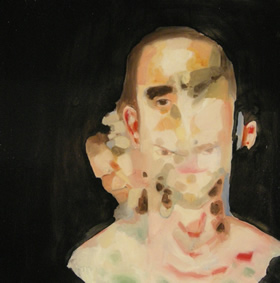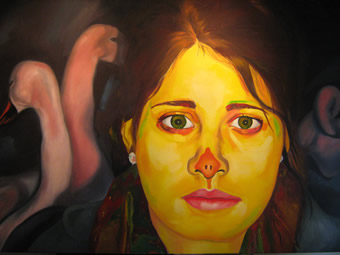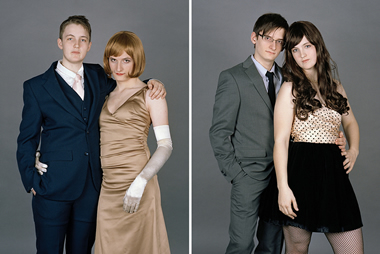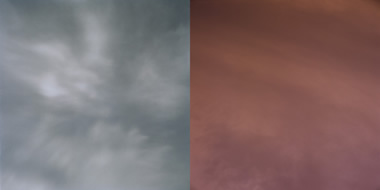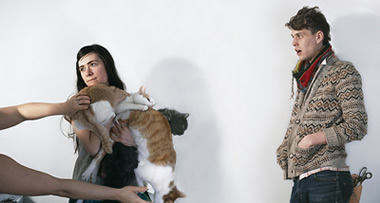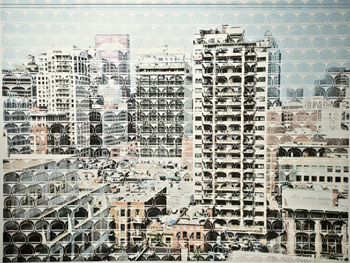
Back to archives | Back to FOFA Gallery
7th Annual Graduating Students’ ExhibitionWe are pleased to present Concordia University’s Faculty of Fine Arts students in the Seventh Annual Fine Arts Graduating Students’ Exhibition. The Graduating Students’ Exhibition is a juried show staged during the weeks surrounding Convocation, and provides an opportunity for the students to display their work in a public venue while celebrating the completion of their course of study. Concordia University’s Faculty of Fine Arts offers an unparalleled range of programs in both the Visual and Performing Arts. The Faculty is known nationally and internationally for the quality of both its faculty and its graduates, with more than 3,000 students currently enrolled in Bachelor’s, Master’s and Doctoral programs and over 18,000 alumni around the world. The York Corridor Vitrines David Malboeuf presents a suite of three small paintings produced from photographs or live models. While also painted in oils and from photographs, the painting of Daniel Lahaise, is intentionally abstracted. He builds upon and examines the missing parts of the medium format photographs he shoots using only a flashlight as light source. There is fascination with the fragility of the masculine body and its ongoing transformation that begins at birth. Bronwen Moen, uses drawing as a tool of reconstruction and mental diagram. This drawing also investigates the very real (and often painful) relationship between our bodies and their causal motions through the environment. Her use of scale allows for fluid transitions between being purely descriptive and visual metaphor. Intentionally non-expressive in nature, the documentary style photographs of Logan Caldbeck, are part of an ongoing series that investigates hunting culture in a sparsely populated area of west Texas. She recognizes that this sort of imagery has become popularized, but her own deeply rural upbringing allows her to see urban dwellers appropriation of a way of life or being as odd. Their idealization of nature and cowboy culture is distinct from her being and ways. While she attempts to be ambiguous in their presentation the impossible ideal of objectivity creates a further resonance in the work. In stark contrast, the work of Kakim Goh, Vertical Landscape, is deeply subjective and romantic in both historical and technical approach. The methods are assembled from a nomadic personal history and the marks are made in a performative dance uniting materials and gestures into an index of the moment of their making. Celebration of self is present in a different way in Switch1 and 2 by JJ Levine. The portrait studio style photographs make an ideal inclusion for a graduating exhibition. While the prom photo is celebratory and raw, conjuring the complex memories of the self at a threshold between adolescence and adulthood and a moment mythologized so often as a one of sexual achievement or arrival, the Switch project examines gender as performance and as something mutable within queer communities. It intentionally problematizes preconceived notions regarding sex, gender, and the body. Anne-Marie Proulx, in turn examines her own face and expressions for hints of her familial lineage, recognizing the role of these other people in the construction of her imagination as well as her appearance and identity. The many ink drawings present the subtleties of difference apparent in a repetitive action and image as echoes of these others. In many ways these multiples create a clearer portrait of the individual than the single channel video, but working in concert they suggest a thread that runs through our Vitrines; they are examinations of representation and perception mediated by the image – these are things to look at. FOFA Gallery The York Corridor entrance to the gallery is animated by two unique works that indicate the breadth of practice within the Studio Arts Faculty. Using kitsch aesthetic, pog style games and a colouring book, Guillaume Boudrias-Plouffe sets forth his invented alter-ego Astroclown to negotiate the world through a proto-scientific strategy named “Stroclologie”. His disarming methods encourage play and pretending as a means of understanding the malaise of another being, and evoke nostalgia for a more childlike time. Beatriz Herrera, also uses kitsch and absurdity, but her project is to try to move between quantitative and qualitative ways of knowing. Trivia Monster, is a blue skinned robot that negotiates its space and us. While its decision making capabilities are entirely numeric, its animal-like presence sets up an uneasy relationship to technology and objects. |
Working in theatre design Samantha Scafidi maintains a strong connection to the expressive nature of drawing and painting often taking the experience of developing the dramatic narratives of theatre back into works of wall based art. Case in point, her drawing, Ubu the King Eats, was inspired by a puppet show she designed for. Regardless of medium or method of dissemination storytelling is central to her practice. Erik Osberg, places significance on the relationship between his psychophysical organism and the devices he makes mechanical recordings with (film camera, still camera, video camera, tape recorder). Osberg performs this relationship to the camera as he runs up and down Mount Royal, the natural emblem of Montreal. His is a working body, going up and down a mountain accompanied by the all too familiar strains of Feist’s 1, 2, 3, 4. The popular song is equally reminiscent of childlike instruction and ubiquitous advertising. Its persistence mirrors his actions going up a mountain for no reason beyond notions of living well, caring for the self, and the cultural constriction that “Being in control of one’s body tends to assume control of one’s mind”. Ali El-Darsa uses media as a method of reconciliation and examination. His video, time of breadth is a document of a conversation between the artist and his mother recounting the Lebanese wars. “it builds aurally from a sense of mystery and the everyday layers to the personal”. It is a portrayal of contemporary micro-politics of identity that reveals through performative gesture and abstract visuals the ongoing vulnerable state of the artist as a result of a painful past and the propaganda that permeates his interior life. The documentary trope of lens based practices allow Katie Jung to elaborate on constructed narratives of gender and its stereotypes in a hyperbolic fashion while still commenting on the reality of the negative connotations and effects of those stereotypes and their inherent sexism. The work is both humourous and agile using large scale printing to further complicate the photographic image and its relationship to both high art and advertising suggesting the wide scope of these false perceptions and the powers at play in their perpetuation.
M. James Hamilton Playford transforms banal and ordinary objects into abstract imagery printed as large scale photographs. Immersive In scale, the works invite imagination, mental and physical engagement simultaneously. The title, Untitled Colour Field #15, recalls the New York abstract painting movement of the 40’s and 50’s that worked with large flat areas of colour. Here though, both the photographic medium and subject matter keep the colour anything but flat. Instead the colour acts as filter to perception and re-informs the viewer, sending us askew ever so slightly. In the front windowAdamo Tiseo’s large painting, A Means to an End, offers no point of reference in its massive expanse of coloured strokes. While it is undeniably a material object, its function as a pictorial image is thwarted, instead it serves as an index of his labours and the thoughts within them. Colour here is put in the service of the mind, selected intuitively and applied with precision, its reference then becomes internal. In the black box Bridget Moser’s two channel video installation integrates pop culture references and radical self expression in an examination of the end of her undergraduate degree. In hopes of producing a “tangible, utilitarian product of her education”, Moser tie-dyed a small stockpile of clothing. She is equally uncertain of the usefulness of either the clothing or her education though put them both into action here. One channel is a re-enactment of the opening credit sequence of the MTV reality show, The City. The show follows a recent university graduate, celebutante Whitney Port, as she enters the professional world of fashion, leaving her women’s studies degree in the dust. Moser has emulated the sequence with a supposition of the activities that will likely reflect her life after graduation. The second channel is deeply affective, as she sports the hideous garments and lets loose, moving as only the unguarded can. The two together suggest the kind of uncertainty mixed with a sense of personal power that is so often the result of the end of accomplishment. While we fully understand this neurosis we are equally certain that there is somewhere new to go, as we celebrate together the graduating class of 2009. (2040) |
© Concordia University
